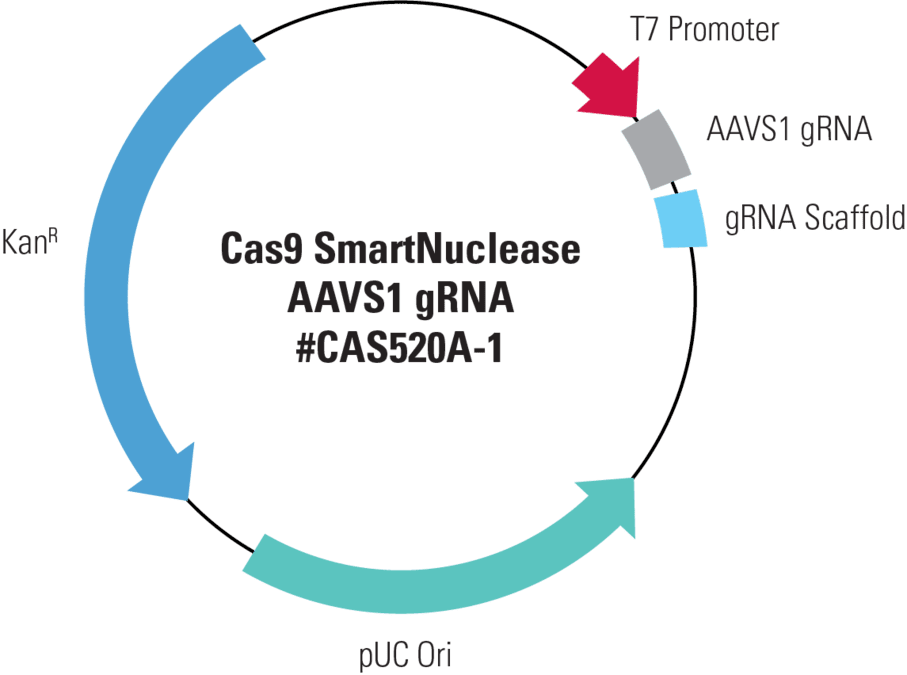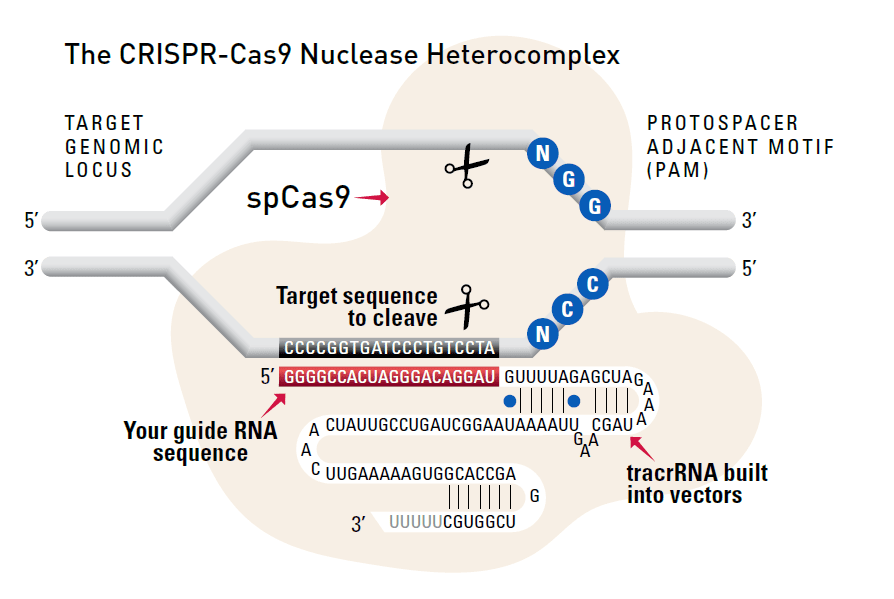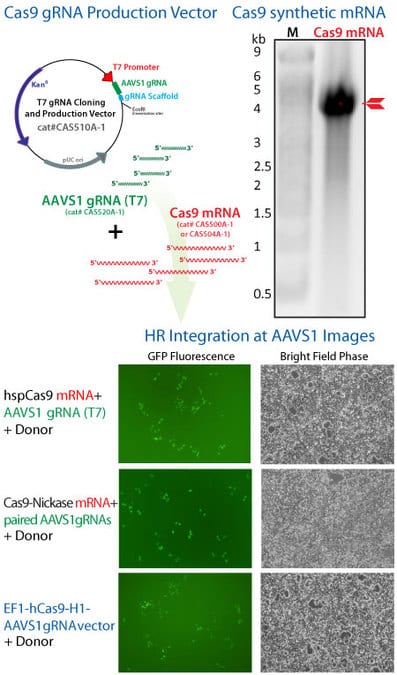Cas9 SmartNuclease™ AAVS1 gRNA, Transfection-ready
- Easy, precise knock-in of any gene
- Consistent, robust transgene expression from the AAVS1 Safe Harbor Site
- Simplified construction of isogenic cell lines
- Minimal off-target integration
- Streamlined CRISPR/Cas9 library screening
Products
| Catalog Number | Description | Size | Price | Quantity | Add to Cart | |||
|---|---|---|---|---|---|---|---|---|
| CAS520A-1 | Transfection-ready Cas9 SmartNuclease AAVS1 gRNA | 10 µg | $429 |
|
||||
Overview
Overview
Easily take advantage of the AAVS1 Safe Harbor Site
Delivering consistent, robust transgene expression, the AAVS1 safe harbor site is a preferred target for gene knock-ins. Insertion at the site has been shown to be safe with no phenotypic effects reported, and the surrounding DNA appears to be kept in an open confirmation, enabling stable expression of a variety of transgenes. The Cas9 SmartNuclease™ AAVS1 gRNA is a pre-built, transfection-ready gRNA that targets Cas9 activity to the AAVS1 Safe Harbor Site.
Co-transfect the Cas9 SmartNuclease AAVS1 gRNA with any of our transfection-ready hspCas9 SmartNuclease mRNAs and an appropriate homologous recombination (HR) targeting vector for gene knock-ins, reporter cell line construction, or any other application where you’d like to take advantage of the AAVS1 Safe Harbor Site.
SBI’s AAVS1 Safe Harbor Targeting products deliver:- Easy, precise knock-in of any gene
- Consistent, robust transgene expression from the AAVS1 Safe Harbor Site
- Simplified construction of isogenic cell lines
- Minimal off-target integration
- Streamlined CRISPR/Cas9 library screening

References
How It Works
How It Works
Targeting the AAVS1 safe harbor site
SBI simplifies gene knock-ins and other genome engineering projects at the AAVS1 Safe Harbor Site with the pre-built Cas9 SmartNuclease AAVS1 gRNA, a selection of HR Targeting Vectors that enable different applications, and tagged and un-tagged transfection-ready hspCas9 SMartNuclease mRNAs. For general guidance on using CRISPR/Cas9 technology for genome engineering, take a look at our CRISPR/Cas9 tutorials as well as the following application notes:
CRISPR/Cas9 Gene Knock-Out Application Note (PDF) »
CRISPR/Cas9 Gene Editing Application Note (PDF) »
CRISPR/Cas9 Gene Tagging Application Note (PDF) »
Or contact our technical support team for immediate answers to your specific questions—email tech@systembio.com.
CRISPR/Cas9 Basics
Through careful selection of the target sequence and design of a donor plasmid for homologous recombination, you can achieve efficient and highly targeted genomic modification with CRISPR/Cas9.
The system
Cas9 protein—uses guide RNA (gRNA) to direct site-specific, double-strand DNA cleavage adjacent to a protospacer adapter motif (PAM) in the target DNA.
gRNA—RNA sequence that guides Cas9 to cleave a homologous region in the target genome. Efficient cleavage only where the gRNA homology is adjacent to a PAM.
PAM—protospacer adapter motif, NGG, is a target DNA sequence that spCas9 will cut upstream from if directed to by the gRNA.
The workflow at-a-glance
DESIGN: Select gRNA and HR donor plasmids. Choice of gRNA site and design of donor plasmid determines whether the homologous recombination event results in a knock-out, knock-in, edit, or tagging.
CONSTRUCT: Clone gRNA into all-in-one Cas9 vector. Clone 5’ and 3’ homology arms into HR donor plasmid. If creating a knock-in, clone desired gene into HR donor.
CO-TRANSFECT or CO-INJECT: Introduce Cas9, gRNA, and HR Donors into the target cells using co-transfection for plasmids, co-transduction for lentivirus, or co-injection for mRNAs.
SELECT/SCREEN: Select or screen for mutants and verify.
VALIDATE: Genotype or sequence putative mutants to verify single or biallelic conversion.
Supporting Data
Supporting Data
Knock-in of GFP at the AAVS1 Safe Harbor Site using Cas9 SmartNuclease AAVS1 gRNA
Figure 1. Cas9 SmartNuclease AAVS1 gRNA directs Cas9 activity to the AAVS1 site to knock-in GFP. METHODS: The Cas9 SmartNuclease AAVS1 gRNA was co-transfected with the Cas9 synthetic mRNA in combination with an AAVS1 HR Targeting Vector harboring a GFP marker. The activities of the Cas9 mRNA + AAVS1 gRNA transfection was compared with that of the EF1 Cas9 SmartNuclease-AAVS1 gRNA All-in-one vector system. Cells were imaged for GFP fluorescence after 3 days.
FAQs
Documentation
Citations
Related Products
Products
| Catalog Number | Description | Size | Price | Quantity | Add to Cart | |||
|---|---|---|---|---|---|---|---|---|
| CAS520A-1 | Transfection-ready Cas9 SmartNuclease AAVS1 gRNA | 10 µg | $429 |
|
||||
Overview
Overview
Easily take advantage of the AAVS1 Safe Harbor Site
Delivering consistent, robust transgene expression, the AAVS1 safe harbor site is a preferred target for gene knock-ins. Insertion at the site has been shown to be safe with no phenotypic effects reported, and the surrounding DNA appears to be kept in an open confirmation, enabling stable expression of a variety of transgenes. The Cas9 SmartNuclease™ AAVS1 gRNA is a pre-built, transfection-ready gRNA that targets Cas9 activity to the AAVS1 Safe Harbor Site.
Co-transfect the Cas9 SmartNuclease AAVS1 gRNA with any of our transfection-ready hspCas9 SmartNuclease mRNAs and an appropriate homologous recombination (HR) targeting vector for gene knock-ins, reporter cell line construction, or any other application where you’d like to take advantage of the AAVS1 Safe Harbor Site.
SBI’s AAVS1 Safe Harbor Targeting products deliver:- Easy, precise knock-in of any gene
- Consistent, robust transgene expression from the AAVS1 Safe Harbor Site
- Simplified construction of isogenic cell lines
- Minimal off-target integration
- Streamlined CRISPR/Cas9 library screening

References
How It Works
How It Works
Targeting the AAVS1 safe harbor site
SBI simplifies gene knock-ins and other genome engineering projects at the AAVS1 Safe Harbor Site with the pre-built Cas9 SmartNuclease AAVS1 gRNA, a selection of HR Targeting Vectors that enable different applications, and tagged and un-tagged transfection-ready hspCas9 SMartNuclease mRNAs. For general guidance on using CRISPR/Cas9 technology for genome engineering, take a look at our CRISPR/Cas9 tutorials as well as the following application notes:
CRISPR/Cas9 Gene Knock-Out Application Note (PDF) »
CRISPR/Cas9 Gene Editing Application Note (PDF) »
CRISPR/Cas9 Gene Tagging Application Note (PDF) »
Or contact our technical support team for immediate answers to your specific questions—email tech@systembio.com.
CRISPR/Cas9 Basics
Through careful selection of the target sequence and design of a donor plasmid for homologous recombination, you can achieve efficient and highly targeted genomic modification with CRISPR/Cas9.
The system
Cas9 protein—uses guide RNA (gRNA) to direct site-specific, double-strand DNA cleavage adjacent to a protospacer adapter motif (PAM) in the target DNA.
gRNA—RNA sequence that guides Cas9 to cleave a homologous region in the target genome. Efficient cleavage only where the gRNA homology is adjacent to a PAM.
PAM—protospacer adapter motif, NGG, is a target DNA sequence that spCas9 will cut upstream from if directed to by the gRNA.
The workflow at-a-glance
DESIGN: Select gRNA and HR donor plasmids. Choice of gRNA site and design of donor plasmid determines whether the homologous recombination event results in a knock-out, knock-in, edit, or tagging.
CONSTRUCT: Clone gRNA into all-in-one Cas9 vector. Clone 5’ and 3’ homology arms into HR donor plasmid. If creating a knock-in, clone desired gene into HR donor.
CO-TRANSFECT or CO-INJECT: Introduce Cas9, gRNA, and HR Donors into the target cells using co-transfection for plasmids, co-transduction for lentivirus, or co-injection for mRNAs.
SELECT/SCREEN: Select or screen for mutants and verify.
VALIDATE: Genotype or sequence putative mutants to verify single or biallelic conversion.
Supporting Data
Supporting Data
Knock-in of GFP at the AAVS1 Safe Harbor Site using Cas9 SmartNuclease AAVS1 gRNA
Figure 1. Cas9 SmartNuclease AAVS1 gRNA directs Cas9 activity to the AAVS1 site to knock-in GFP. METHODS: The Cas9 SmartNuclease AAVS1 gRNA was co-transfected with the Cas9 synthetic mRNA in combination with an AAVS1 HR Targeting Vector harboring a GFP marker. The activities of the Cas9 mRNA + AAVS1 gRNA transfection was compared with that of the EF1 Cas9 SmartNuclease-AAVS1 gRNA All-in-one vector system. Cells were imaged for GFP fluorescence after 3 days.



